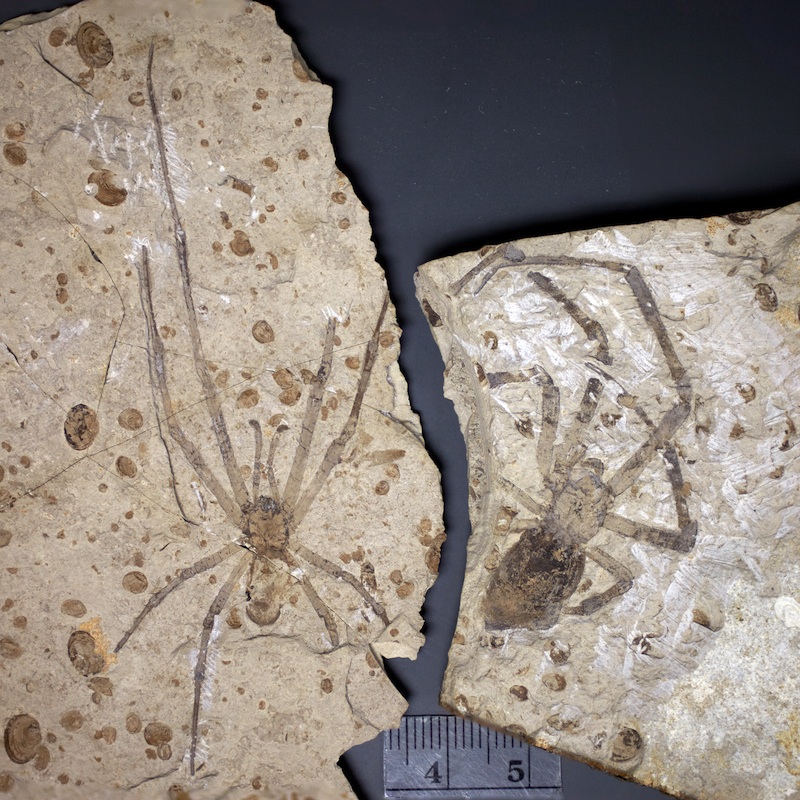Biggest Spider Fossil Now Has a Mate — But It's Complicated

A few years ago, scientists uncovered the largest-ever fossil of spider: a female representative of a never-before-seen species that was buried in volcanic ash during the age of the dinosaurs.
Now the researchers say they have found an adult male spider to match, but the discovery complicates the original interpretation of the species. The scientists have proposed a new genus — Mongolarachne — to describe the extinct creature.
When researchers first found the female spider in northern China, they named it Nephila jurassica, putting it in the Nephila genus of golden silk orb-weavers, which still exist today and have been known to ensnare birds and bats in their huge wheel-shaped webs. [Ewww! See Photos of Bat-Eating Spiders in Action]
"It was so much like the modern golden orb weaver," said Paul Selden, a paleontologist with the University of Kansas. "We couldn't find any reason not to put it in the same genus of the modern ones."
With soft, squishy bodies, spiders don't typically turn up in the fossil record, but several hundred have been found in the volcanic deposits at the Daohugou fossil beds in Inner Mongolia, Selden said.
Volcanic ash is famous for preserving more ephemeral pieces of the past, from bodies buried in their death poses at Pompeii to 2.7-billion-year-old raindrop impressions found in South Africa. Researchers think these spiders were likely swept to the bottom of a sub-tropical lake and covered in fine ash after a volcano blew its lid.
Unlike insects, spiders are typically pretty good at staying away from water, Selden explained.
Sign up for the Live Science daily newsletter now
Get the world’s most fascinating discoveries delivered straight to your inbox.
"It would take something like a volcanic eruption to blow them into the bottom of the lake and bury them," Selden told LiveScience. "That's the sort of scenario we imagine."
And in that volcanic rock layer at Daohugou, the researchers found another spider that looked remarkably similar to Nephila jurassica, except it was male. There were several clues in the newfound fossil, however, that suggest this ancient arachnid just doesn't fit the bill for Nephila.
First of all, the male was remarkably quite similar in size to the female, with a body that measures 0.65 inches (1.65 centimeters) long and a first leg stretching 2.29 inches (5.82 cm).
"This is rather strange," Selden said. "In the modern orb weavers, there is quite a lot of sexual dimorphism," with a huge female and a tiny male.
Compared with Nephila male spiders, this newfound fossilized male had more primitive-looking pedipalps — the sex appendages between a spider's jaws and first legs that it uses to transfer sperm to the female. And it had a more feathery hairstyle: The fossil was preserved so well that Selden could look at imprints of the spider's hair under an electron microscope. Instead of one or two scales along each bristle, Selsen said he saw evidence that this spider had "spirals of hairlets" along the strands covering its body.
The researchers think the fossilized spiders may actually be more closely related to spiders in the Deinopoidea genus, also called ogre-faced spiders. Arachnids in this group are considered orbicularians. They also make orb-shaped webs, but their silk is more "woolly," Selden said, with a stickiness that's more like Velcro than glue.
Revising their original labeling of the giant fossilized female spider, the researchers created a new genus and species name for the pair: Mongolarachne jurassica. Selden and colleagues also created a branch for Mongolarachne on a phylogenic tree, placing it quite close to the stem where orbicularians originate.
The study was published online Dec. 7 in the journal Naturwissenschaften.
Follow Megan Gannon on Twitter and Google+. Follow us @livescience, Facebook & Google+. Original article on LiveScience.

